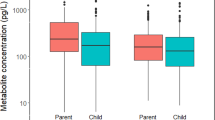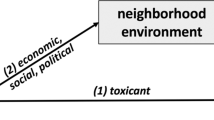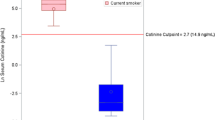Abstract
The detection of polycyclic aromatic hydrocarbon (PAH)-DNA adducts in human lymphocytes may be useful as a surrogate end point for individual cancer risk prediction. In this study, we examined the relationship between environmental sources of residential PAH, as well as other potential factors that may confound their association with cancer risk, and the detection of PAH-DNA adducts in a large population-based sample of adult women. Adult female residents of Long Island, New York, aged at least 20 years were identified from the general population between August 1996 and July 1997. Among 1556 women who completed a structured questionnaire, 941 donated sufficient blood (25+ ml) to allow use of a competitive ELISA for measurement of PAH-DNA adducts in peripheral blood mononuclear cells. Ambient PAH exposure at the current residence was estimated using geographic modeling (n=796). Environmental home samples of dust (n=356) and soil (n=360) were collected on a random subset of long-term residents (15+ years). Multivariable regression was conducted to obtain the best-fitting predictive models. Three separate models were constructed based on data from : (A) the questionnaire, including a dietary history; (B) environmental home samples; and (C) geographic modeling. Women who donated blood in summer and fall had increased odds of detectable PAH-DNA adducts (OR=2.65, 95% confidence interval (CI)=1.69, 4.17; OR=1.59, 95% CI=1.08, 2.32, respectively), as did current and past smokers (OR=1.50, 95% CI=1.00, 2.24; OR=1.46, 95% CI=1.05, 2.02, respectively). There were inconsistent associations between detectable PAH-DNA adducts and other known sources of residential PAH, such as grilled and smoked foods, or a summary measure of total dietary benzo-[a]-pyrene (BaP) intake during the year prior to the interview. Detectable PAH-DNA adducts were inversely associated with increased BaP levels in dust in the home, but positively associated with BaP levels in soil outside of the home, although CIs were wide. Ambient BaP estimates from the geographic model were not associated with detectable PAH-DNA adducts. These data suggest that PAH-DNA adducts detected in a population-based sample of adult women with ambient exposure levels reflect some key residential PAH exposure sources assessed in this study, such as cigarette smoking.
This is a preview of subscription content, access via your institution
Access options
Subscribe to this journal
Receive 6 print issues and online access
$259.00 per year
only $43.17 per issue
Buy this article
- Purchase on Springer Link
- Instant access to full article PDF
Prices may be subject to local taxes which are calculated during checkout
Similar content being viewed by others
Abbreviations
- PAH:
-
polycylic aromatic hydrocarbons
- SD:
-
standard deviation
- OR:
-
odds ratio
- CI:
-
confidence interval
- LIBCSP:
-
Long Island Breast Cancer Study Project
- BaP:
-
benzo-(a)-pyrene
- FFQ:
-
food frequency questionnaire
- BMI:
-
body mass index.
References
Besarati N.A., et al. Biomonitoring of tobacco smoke carcinogenicity by dosimetry of DNA adducts and genotyping and phenotyping of biotransformational enzymes: a review on polycyclic aromatic hydrocarbons. Biomarkers 2002: 7: 209–229.
Beyea J., and Hatch M. Geographic exposure modeling: a valuable extension of GIS for use in environmental epidemiology. Environ Health Perspect 1999: 107: 181–190.
Beyea J., et al. Historical reconstruction of exposure to polycyclic aromatic hydrocarbons and model validation: examples from the Long Island Breast Cancer Study Project. International Association for Environment Exposures and Exposure Assessment, Vancouver, BC, August, 2002.
Cantwell M., et al. Relative validity of a food frequency questionnaire with a meat-cooking and heterocyclic amine module. Cancer Epidemiol Biomarkers Prev 2004: 13: 293–298.
Fertmann R., et al. Evaluation of ambient air concentrations of polycyclic aromatic hydrocarbons in Germany from 1990 to 1998. J Expos Anal Environs Epidemiol 2002: 12: 115–123.
Gammon M.D., et al. Environmental toxins and breast cancer on Long Island. I. Polycyclic aromatic hydrocarbons (PAH)-DNA adducts. Cancer Epidemiol Biomarkers Prev 2002a: 11: 677–685.
Gammon M.D., et al. The Long Island Breast Cancer Study Project: description of a multi-institutional collaboration to identify environmental risk factors for breast cancer. Breast Cancer Res Treatment 2002b: 74: 235–254.
Gammon M.D., et al. Environmental tobacco smoke and breast cancer incidence. Environ Res 2003: 96: 176–185.
Gammon M.D., et al. Polycylic aromatic hydrocarbon (PAH)-DNA adducts and breast cancer: a pooled analysisx. Arch of Environ Health 2005, in press.
Georgiadis P., et al. AULIS Network, Biomarkers of genotoxicity of air pollution (the AULIS project): bulky DNA adducts in subjects with moderate to low exposures to airborne polycyclic aromatic hydrocarbons and their relationship to environmental tobacco smoke and other parameters. Carcinogenesis 2001: 22: 1447–1457.
Gorlewska-Roberts K., et al. Carcinogen-DNA adducts in human breast epithelial cells. Environ Mol Mutagen 2002: 39: 184–192.
Grzybowska E., Hemminki K., and Chorazy M. Seasonal variation in levels of DNA adducts and X-spots in human populations living in different parts of Poland. Environ Health Perspect 1993: 99: 77–81.
Gupta K.P., and Singh J. Modulation of carcinogen metabolism and DNA interaction by calcium glucarate in mouse skin. Toxicol Sci 2004: 79: 47–55.
Hansen A.M., et al. Seasonal and biological variation of urinary epinephrine, norepinephrine, and cortisol in healthy women. Clin Chim Acta 2001: 309: 25–35.
Harris C.C., et al. Differences in metabolism of chemical carcinogens in cultured human epithelial tissues and cells. J Cell Biochem 1982: 18: 285–294.
Hecht S.S. Chemoprevention of cancer by isothiocyanates, modifiers of carcinogen metabolism. J Nutr 1999: 129: 768S–774S.
Hecht S.S. Inhibition of carcinogenesis by isothiocyanates. Drug Metab Rev 2000: 32: 395–411.
Holdaway I.M., et al. Seasonal variation in the secretion of mammotrophic hormones in normal women and women with previous breast cancer. Breast Cancer Res Treat 1997: 42: 15–22.
Hosmer D.W., and Lemeshow S. Applied Logistic Regression. John Wiley & Sons, New York, 1989.
I.A.R.C. Monographs on the Evaluation of the Cacinogenic Risk of Chemicals to Humans. Polynuclear Aromatic Compounds; Part 3, Industrial Exposures in Aluminium Production, Coal Gasification, Coke Production, and Iron and Steel Founding. IARC, Lyons, France, 1984.
Jeffy B.D., Chirnomas R.B., and Romagnolo D.F. Epigenetics of breast cancer: Polycyclic aromatic hydrocarbons as risk factors. Environ Mol Mutagen 2002: 3: 235–244.
Josyula S., et al. Age-related alterations in 32P-postlabeled DNA adducts in livers of mice infected with the tumorigenic bacterial pathogen, Helicobacter hepaticus. Int J Oncol 2000: 17: 811–818.
Kang D.H., et al. Interindividual differences in the concentration of 1-hydroxypyrene-glucuronide in urine and polycyclic aromatic hydrocarbon-DNA adducts in peripheral white blood cells after charbroiled beef consumption. Carcinogenesis 1995: 16: 1079–1085.
Kazerouni N., et al. Analysis of 200 food items for benzo[a]pyrene and estimation of its intake in an epidemiologic study. Food Chem Toxicol 2001: 39: 423–436.
Kiyohara C., and Hirohata T. Environmental factors and aryl hydrocarbon hydroxylase activity (CYP1A1 phenotype) in human lymphocytes. J Epidemiol 1997: 7: 244–250.
Kleinbaum D.G., et al. Applied Regression Analysis and Other Multivariable Methods. Brooks/Cole Publishing Company, Pacific Grove, 1998.
Kriek E., et al. DNA adducts as a measure of lunch cancer risk in humans exposed to polycyclic aromatic hydrocarbons. Environ Health Perspect 1993: 99: 71–75.
Lewis R.G., et al. Distribution of pesticides and polycyclic aromatic hydrocarbons in house dust as a function of particle size. Environ Health Perspect 1999: 107: 721–726.
Lijinsky W. The formation and occurrence of polynuclear aromatic hydrocarbons associated with food. Mutat Res 1991: 259: 251–261.
Lioy P.J., and Greenberg A. Factors associated with human exposures to polycyclic aromatic hydrocarbons. Toxicol Ind Health 1990: 6: 209–223.
Maes M., and De Meyer F. Relationships of climatic data to immune and hematologic variables in normal human. Neuroendocrinol Lett 2000: 21: 127–136.
Mastrangelo G., Fadda E., and Marzia V. Polycyclic aromatic hydrocarbons and cancer in man. Environ Health Perspect 1996: 104: 1166–1170.
Moller L., et al. Seasonal variation of DNA adduct pattern in human lymphocytes analyzed by 32P-HPLC. Carcinogenesis 1996: 17: 61–66.
Mooney L.A., et al. Decline of DNA damage and other biomarkers in peripheral blood following smoking cessation. Cancer Epidemiol Biomarkers Prev 1995: 4 (6): 627–634.
Myrianthefs P., et al. Seasonal variation in whole blood cytokine production after LPS stimulation in normal individuals. Cytokine 2003: 24: 286–292.
Nelson R.J., and Drazen D.L. Melatonin mediates seasonal changes in immune function. Ann NY Acad Sci 2000: 917: 404–415.
Odabasi M., et al. Measurement of dry deposition and air–water exchange of polycyclic aromatic hydrocarbons with the water surface sampler. Environ Sci Technol 1999: 33: 426–434.
Paigen B., et al. Seasonal variation of hydrocarbons hydrolase activity in human lymphocytes. Cancer Res 1981: 41: 2757–2761.
Palli D., et al. Diet, metabolic polymorphisms and DNA adducts: the EPIC-Italy cross-sectional study. Int J Cancer 2000: 87: 444–451.
Paradiso A., et al. Predictability of monthly and yearly rhythms of breast cancer features. Breast Cancer Res Treat 2001: 67: 41–49.
Peluso M., et al. 32P-postlabelling detection of aromatic adducts in the white blood cell DNA of nonsmoking police officers. Cancer Epidemiol Biomarkers Prev 1998: 7: 3–11.
Peluso M., et al. White blood cell DNA adducts and fruit and vegetable consumption in bladder cancer. Carcinogenesis 2000: 21: 183–187.
Perera F.P., et al. Detection of polycyclic aromatic hydrocarbon-DNA adducts in white blood cells of foundry workers. Cancer Res 1988: 48 (8): 2288–2291.
Perera F.P., et al. DNA adducts and related biomarkers in populations exposed to environmental carcinogens. Environ Health Perspect 1992a: 98: 133–137.
Perera F.P., et al. Molecular and genetic damage in humans from environmental pollution in Poland. Nature 1992b: 360: 256–258.
Phillips D.H. Polycyclic aromatic hydrocarbons in the diet. Mutation Res 1999: 443: 139–147.
Poirier M.C., et al. Quantitation of benzo(a)pyrene-deoxyguanosine adducts by radioimmunoassay. Cancer Res 1980: 40: 412–416.
Poirier M.C., et al. Carcinogen macromolecular adducts and their measurement. Carcinogenesis 2000: 21: 353–359.
Potischman N., et al. Dietary relationships with early onset (under age 45) breast cancer in a case-control study: influence of chemotherapy treatment. Cancer Causes Control 1997: 8: 713–721.
Rothman N., et al. Formation of polycyclic aromatic hydrocarbon-DNA adducts in peripheral white blood cells during consumption of charcoal-broiled beef. Carcinogenesis 1990: 11: 1241–1243.
Rothman N., et al. Contribution of occupation and diet to white blood cell polycyclic aromatic hydrocarbon-DNA adducts in wildland firefighters. Cancer Epidemiol Biomarkers Prev 1993a: 2: 341–347.
Rothman N., et al. Association of PAH-DNA adducts in peripheral white blood cells with dietary exposure to polyaromatic hydrocarbons. Environ Health Perspect 1993b: 99: 265–267.
Rothman, et al. The impact of glutathione s-transferase M1 and cytochrome P450 1A1 genotypes on white-blood-cell polycyclic aromatic hydrocarbon-DNA adduct levels in humans. Mol Carcinog 1995: 14: 63–68.
Santella R.M., et al. Cigarette smoking related polycylic aromatic hydrocarbon-DNA adducts in peripheral mononuclear cells. Carcinogenesis 1992: 13: 2041–2045.
Santella R.M. Immunological methods for detection of carcinogen-DNA damage in humans. Cancer Epidemiol Biomarkers Prev 1999: 8: 733–739.
Scherer G., et al. Biomonitoring of exposure to polycyclic aromatic hydrocarbons of nonoccupationally exposed persons. Cancer Epidemiol Biomarkers Prev 2000: 9: 373–380.
Topinka J., et al. Genotoxicity of urban air pollutants in the Czech Republic. Part II. DNA adduct formation in mammalian cells by extractable organic matter. Mutat Res 2000: 469: 83–93.
Tuominen R., et al. Susceptibility factors and DNA adducts in peripheral blood mononuclear cells of aluminium smelter workers exposed to polycyclic aromatic hydrocarbons. Arch Toxicol 2002: 76: 178–186.
United States Census Bureau. 2000, United States Census Bureau: American fact finder, age groups and sex 2000. http://factfinder.census.gov/home/saff/main.htmlAccessed 19 November 2003.
Van Schooten F.J., et al. Postlabeling of aromatic DNA adducts in white blood cells and alveolar macrophages of smokers: saturation at high exposures. Mutat Res 1997: 378: 65–75.
Vineis P. DNA adducts as markers of exposure to carcinogens and risk of cancer. Int J Cancer 2000: 88: 325–328.
Vineis P., et al. Leveling-off of the risk of lung and bladder cancer in heavy smokers: an analysis based on multicentric case-control studies and a metabolic interpretation. Mutat Res 2000: 463: 103–110.
Vineis P., et al. Tobacco and cancer: recent epidemiological evidence. J Nat Cancer Inst 2004: 96: 99–106.
Waksberg J. Sampling methods for random digit dialing. J Am Stat Assoc 1978: 73: 40–46.
Walker B.R., et al. Seasonal variation in glucocorticoid activity in healthy men. J Clin Endocrinol Metab 1997: 82: 4015–4019.
Wiencke J.K., et al. Early age at smoking initiation and tobacco carcinogen DNA damage in the lung. J Nat Cancer Inst 1999: 91: 614–619.
Wiencke J.K. DNA adduct burden and tobacco carcinogenesis. Oncogene 2002: 21: 7376–7391.
Wild C.P., and Pisani P. Carcinogen DNA and protein adducts as biomarkers of human exposure in environmental cancer epidemiology. Cancer Detect Prev 1998: 22: 273–283.
Acknowledgements
This work was supported in part by grants from the National Cancer Institute and the National Institutes of Environmental Health and Sciences (Grant nos. UO1CA/ES66572, P30ES09089, and P30ES10126), the Breast Cancer Research Foundation, and the Babylon Breast Cancer Coalition. IRB approval was obtained by all collaborating institutions. The study was conducted in accordance with national and institutional guidelines for the protection of all study participants. For their valuable contributions to the Long Island Breast Cancer Study Project the authors thank: members of the Long Island Breast Cancer Network; the 31 participating institutions on Long Island and in New York City, NY, USA; our National Institutes of Health collaborators, Gwen Collman, PhD, National Institutes of Environmental Health Sciences; G. Iris Obrams, MD, PhD formerly of the National Cancer Institute; members of the External Advisory Committee to the population-based case–control study: Leslie Bernstein, PhD, (Committee chair); Gerald Akland, MS; Barbara Balaban, MSW; Blake Cady, MD; Dale Sandler, PhD; Roy Shore, PhD; and Gerald Wogan, PhD; as well as other collaborators who assisted with various aspects of our data collection efforts including Mary Wolff, PhD; Gail Garbowski, MPH; H. Leon Bradlow, PhD; Martin Trent, BS; Ruby Senie, PhD; Carla Maffeo, PhD; Pat Montalvan; Gertrud Berkowitz, PhD; Margaret Kemeny, MD; Mark Citron, MD; Freya Schnabel, MD; Allen Schuss, MD; Steven Hajdu, MD; and Vincent Vinciguerra, MD.
Author information
Authors and Affiliations
Corresponding author
Rights and permissions
About this article
Cite this article
Shantakumar, S., Gammon, M., Eng, S. et al. Residential environmental exposures and other characteristics associated with detectable PAH-DNA adducts in peripheral mononuclear cells in a population-based sample of adult females. J Expo Sci Environ Epidemiol 15, 482–490 (2005). https://doi.org/10.1038/sj.jea.7500426
Received:
Accepted:
Published:
Issue Date:
DOI: https://doi.org/10.1038/sj.jea.7500426
Keywords
This article is cited by
-
Aromatic DNA adducts in relation to dietary and other lifestyle factors in Spanish adults
European Food Research and Technology (2009)
-
IGHMBP2 Thr671Ala polymorphism might be a modifier for the effects of cigarette smoking and PAH–DNA adducts to breast cancer risk
Breast Cancer Research and Treatment (2006)



